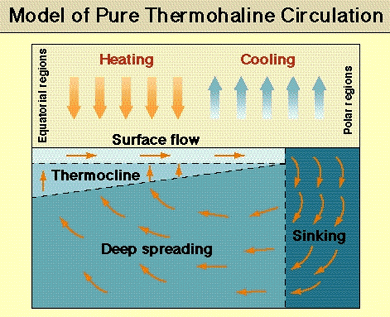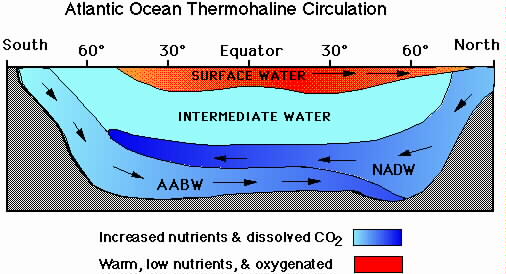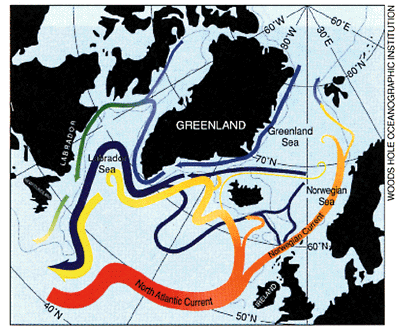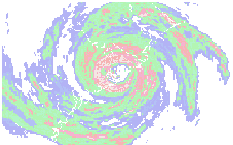Thermohaline
circulation
The system of surface and subsurface ocean currents that is driven by
temperature and salinity differences that create density gradients between
adjoining water masses. They are responsible for moving great amounts of
thermal energy around the globe.

The thermohaline
circulation is a density-driven, global ocean circulation. Sometimes called the
Conveyor Belt, the thermohaline circulation moves warmer waters poleward
and cold bottom waters equatorward.The North Atlantic Ocean (near the Greenland
and Norwegian Seas) and the Antarctic Ocean (near the Weddell Sea) are prime
spots for density-induced downwelling, which drives thermohaline circulations.
The North Atlantic Thermohaline Circulation has many effects on weather
patterns and events. It is linked with the North Atlantic Oscillation
(NAO), a multi-decadal oscillation in pressure (or sea surface temperature) in
the same vicinity. Current research on thermohaline circulation has exploded as
more and more impacts on humans are found.

North
Atlantic Deep Water (NADW)
Cold and salty water from the North Atlantic that, because of its greater
density, sinks to the bottom of the sea and drives a great underwater
"conveyor belt" current around the world's oceans that ultimately
returns via the surface current of the Gulf Stream.
A thermohaline
circulation is fueled by density changes (Henrichs,
2000).Density is a function of temperature and salinity (and pressure, which
is usually neglected).This explains why the circulation is termed thermohaline
(Appenzeller,
1997). Ocean water density is directly proportional to salinity, but
inversely proportional to sea surface temperature (SST).SST anomalies are much
more pronounced than salinity variations in the open oceans, and are thus more
responsible for density variations in ocean waters than are salinity changes.
However, circulation centers in the Mediterranean Sea and the Red Sea are
salinity-induced (Gorton,
2000). Salinity decreases when water is added to the system in the following
ways: precipitation, sea ice melting, or land runoff. Evaporation and ice
formation cause salinity levels to increase.

The thermohaline circulation has numerous effects on a coupled ocean
and atmosphere. Since warm waters are driven northward, this contributes to the
unusually mild European winters. This effect from the thermohaline Conveyor
Belt is said to be twice as important as the Gulfstream (Appenzeller,
1997).In addition, the shifts in temperature and salinity affect marine
ecology in the North Atlantic.Colder waters are nutrient-rich and contain a
great deal of dissolved carbon dioxide, whereas warmer waters are oxygenated
and stripped of nutrients. The Conveyor Belt is also a major forcing on
hurricane activity in the North Atlantic basin (Gray
et al., 2000). Hurricanes are comparable to heat engines, feeding off of
warm SSTs. The stronger the thermohaline circulation, the more favorable
tropical cyclone activity becomes, since a larger area has warm SSTs.

The thermohaline
circulation has been modeled to gain further insight into its impacts. One idea
that baffles scientists is the lack of a thermohaline circulation in the
Pacific Ocean (Zachos,
1999).Also, there is speculation that the thermohaline circulation may
cease to exist if carbon dioxide levels continue to rise, causing extensive
global warming. This would have a tremendous effect on global climate. Finally,
significant research is being conducted to completely understand the link
between the North Atlantic Oscillation and the Conveyor Belt.
Click here for more
information about the North Atlantic Oscillation
Appenzeller, Christof. “Draft Fact-sheet
Thermohaline Circulation.” 1997. http://www.climate.unibe.ch/~christof/div/fact4thc.html
(April 2, 2000)
Gorton, Arnold L. “Thermohaline Circulation.” Updated
2000. http://www.britannica.com/bcom/eb/article/3/0,5716,115013+12,00.html
(April 2, 2000)
Gray, et al. “Early April Forecast of
Atlantic Seasonal Hurricane Activity and U.S. Landfall Strike Probabilities for
2000.” April 1, 2000. http://typhoon.atmos.colostate.edu/forecasts/2000/april2000
(April 15, 2000)
Henrichs, Susan M. “Density and Thermohaline Circulation.” 2000.
http://www2.sfos.uaf.edu:8080/msl111/notes/den.html (April 2, 2000)
Wormuth, John. “Thermohaline Circulation.” Updated 1999.
http://www-ocean.tamu.edu/~wormuth/thermohaline.html (April 2, 2000)
Zachos, James. “Lecture #15: Polar
Oceans, Ice, and Thermohaline Circulation.”
1999. http://wwwcatsic.ucsc.edu/~eart1/Notes/Lec15.html
(A pril 2, 2000)

Author:
Anthony Arguez
Florida State University Senior
Majoring in Meteorology and Environmental Studies
Graduating August 2000
Center for Ocean-Atmospheric Prediction
Studies
Written: April
20, 2000
Contact me
at anthony@coaps.fsu.edu
Check out my
webpage: http://www.coaps.fsu.edu/bios/arguez.shtml
Why I made this corny page: http://www.ocean.fsu.edu/~www/Courses/sp00H1001/Paper.html
Webpage
reviews: http://www.ocean.fsu.edu/~www/Courses/sp00H1001/aarguez/AnthonyAreviews.html